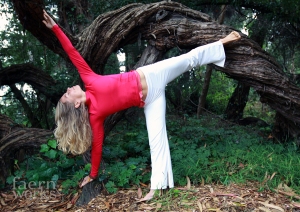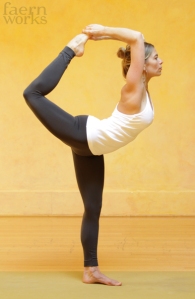pose of the month- Adho Mukha Vrksasana
with chrisandra fox photography by faern

Adho Mukha Vrksasana
Downward-facing Tree Pose
with Chrisandra Fox

As a little girl, I had practice of throwing my legs up against the front door of the house, and standing on my hands as long as I could. Each summer, I practiced these handstands on the beach, with no door. Often, I would fall, bringing my legs out to one side, or into Urdhva Dhanurasana (upward-facing wheel), which is how I learned to love backbends. Once in a great while, I would find my balance on the hard sand near the water’s edge. Time would stop and in those precious moments of exhilarating awe, I would try very hard to remember exactly what I had done so that I could repeat the experience.
Handstand gives us the moment of our power – a moment of pure potential – where we may yoke our root and our expansiveness in a single breath cycle. We learn to engage our bodies harmoniously, strengthen our core, sharpen our concentration, expand awareness and engage the mysteries of gravity and levity on a physical level. Handstand asks us to build strength in new areas, heighten coordination and reaction time, and trust that our bodies, and our egos, can take a fall.
When we practice handstand – at the wall or free standing against Nature’s backdrop – we literally turn our worlds upside down for a moment or more of truly exploring the unknown. Within that moment, we may find the power of living in true potential. We may fall to one side or another. We may not be able to kick up every day. Some days, our wrists hurt, our shoulders feel tight, and we can’t find the internal support of our breath and our bandhas to sustain balance. And more, we may meet an incredible fear and discomfort towards going upside down.

But handstands were child’s play for many of us, when we were children. And for those of us who are rediscovering that childlike nature through our yoga practice, there are tools we can use to make this journey to our center one of joy, power, and grace.
Handstand Preparation
The Wrists
Often the biggest obstacle to standing on the hands is meeting the weakness of the wrists. If you suffer from carpel tunnel, you may want to avoid handstand for now and work inversions that strengthen the shoulders, like dolphin pose. The following exercise will help alleviate stiffness and mobilize the wrists:
Sit or stand. Interlace your fingers and press your forearms together, bringing the elbows to the level of the shoulders. Circle the wrists in one direction, 10-20 times. Feel the movement of the bones in the wrists, through the forearms and in the elbow. Maintain a steadiness in your shoulder blades as you rotate the wrists in one direction, then in the opposite direction.
The Shoulders
Keep your fingers interlocked and press through the center of your palms, lifting the arms overhead. Lengthen through your inner elbows, and lower your chin slightly towards the center of your throat. Soften the tops of your shoulders as you root your shoulder blades on your back ribs. Continue to press through the center of your palms. Can you feel a sense of grounding in your shoulders and the navel center, even while you explore that wonderful stretch?
Now lift your head and draw back through the crown, arching your neck and turning your gaze towards your brow center. Take a few breaths, still anchoring the shoulder blades and feeling a sense of length through the front of your neck towards your chin. Bring your head back to center and release your arms to your sides.
The Abdomen
Once you turn upside down, you will want to engage through your core to support the lower body. You’ll feel a natural toning of your abdominal wall in handstand, and you can further build this strength through the following exercise:
Lie down on your back. Lift your arms up overhead and press the backs of them to the floor. Lift your legs to 90°. If your low back is tight, you may try this one leg at a time. Point your toes and lower your legs towards the ground as you inhale. Flex through your feet and lift your legs back to 90° as you exhale. Repeat, keeping your pelvis steady and your inner knees firm.
The Third Arm Eye
A tripod is more stable that a two-legged chair, and so for handstand, we can use our drishti, or eye gaze, to create a third arm.
Come into Adho Mukha Svanasana (downward-facing dog) with your fingers a hand’s width from the wall. Broaden your shoulder blades from your upper spine, outwardly spiral your upper arms, and feel for a sense of grounding in your forearm bones. Turn your gaze to the line where the wall meets the floor. This is about where you will direct the focus of your eyes when you come up into handstand.






The Pose
Handstand at the Wall
Continue in downward-facing dog at the wall. Lift one leg toward the sky, rooting the pads of your fingers to the earth. Feel the tone of your abdomen as you extend the leg. Repeat on the other side. Now, step one foot halfway to the hands, bend your knee and lift your other leg with a firm press into the ball of the standing foot. You may need to kick the extended leg towards the wall, but keep feeling the root of your leg in your navel center. As you kick your leg up, it will carry your pelvis. The more awareness you have in your legs, the lighter they will become. Let your second leg follow the first with great enthusiasm.
The Work
As you kick up, keep your legs active and engaged, as you did while practicing your leg lifts. This will literally lighten the load for your arms and your shoulders. Press your heel bones against the wall and reach actively through the soles of your feet, as though you are standing on them. Bring your inner knees together.
Have you kept your third arm steady? If not, re-establish your focus through the gaze of your eyes. Continue to anchor your shoulder blades on your back ribs while you lengthen through your inner elbows. Wrists hurt? Give more pressure to the finger pads, as though you are clawing the earth. If your wrists feel fine, give your weight to the roots of your fingers, working with equal effort to awaken the sense of earth energy “lifting” up through the palm of your hand.
Once up, tone your navel to your spine and lengthen your tailbone towards your heels. This will shorten the distance between the pubic bones and the front ribcage, thus eliminating the “banana” shape that often occurs when we fall into our low backs.
Breathe steadily. Feel the orchestra of your body harmonizing, as gravity anchors your shoulders, forearms, and hands, and your legs and feet become firm and light. You may feel an incredible root through your navel as an unbearable lightness lifts and tones your pelvic floor.
Variations
You can release the neck and gaze directly ahead in handstand. This will bring your head and pelvis into alignment, and help you to pull in towards the midline of your body. As you lift your head and engage your third arm gaze, this will lengthen your abdomen and allow you to play with balancing the shoulders and pelvis.
Play! Keep one heel pressed firmly against the wall, point the toes of your second foot and slowly lower your leg towards the ground. You’ll feel a hollowing out in the belly as you lower your leg. Then, on an inhalation, lift that leg right back up to handstand, feeling the length of the abdomen. Change sides. This exercise will strengthen your abdomen, spinal muscles, low back, wrists, and shoulders, and prepare you for floating up to handstand with effortlessness.
Handstand without the Wall
With the support of a friend, you can reduce your need for the wall. Take your downward-facing dog, and have your friend stand to one side of your hands. Tell your friend which leg you are kicking up with before you kick. Your friend extends her arm parallel to the earth, just above your hands. You kick up with one leg to meet her extended arm. Take the second leg to meet the first. Your friend may place a fist between your knees for you to squeeze, or she may place her hand above your feet for you to press up into. Reach through the soles of your feet, spreading your toes and lifting through your inner ankles.
Falling
Falling is inevitable, and the more comfortable we become with “falling” out of pose, the more we learn about how not to fall. As you fall out, fall to the side or back to your downward-facing dog. Fall with awareness. Feel your body move through its descent to find earth. Friends, let go of your partner’s legs. Like cats, our feet know how to find the ground, but we must be free in order to do so.
If you have a practice of urdhva dhanurasana or upward-facing bow pose, you can practice coming out of your handstands by slowly falling back, and bringing your feet to the floor. Stay steadily rooted through your hands.
If fear is the obstacle, place a bolster against the wall, so you have something to “catch” your head as you kick up. Use your inhalation to kick up, and as you exhale, pull into your midline. Remember to use your eyes to maintain a sense of internal steadiness.
Once you begin to unlock the mysteries of your relationship with gravity through handstand, you might find yourself practicing anywhere and everywhere. Plant your hands in the grass, on dirt, in sand, on rock, on the pool’s cement bottom, even on the concrete outside your building. Establish your gaze and float up to your moment of power and potential against a wall, a tree, or nothing at all.


Chrisandra Fox teaches handstands and other postures at Yoga Tree 5 classes per week, and leads The Heart of Renewal Retreats. To check out her class schedule, visit http://www.yogatreesf.com/teachers/chrisandra_fox.htm.
all photos courtesy of faern at http://www.faernworks.com
originally posted at :
http://faern-in-the-works.com/2009/09/29/pose-of-the-month-adho-mukha-vrksasana/
and
http://www.yogatreesf.com/newsletter/images/sep09_pose.html



















